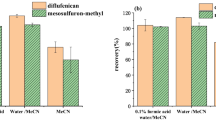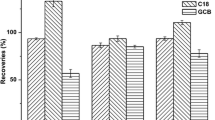Abstract
The supervised field trials were conducted in maize crops using nano-microemulsion (NM) and a commercial formulation of indoxacarb and lufenuron to evaluate the effect of nano-formulation on the dissipation pattern. A modified QuEChERS (Quick Easy Cheap Effective Rugged and Safe)-UPLC-MS/MS (ultra-performance liquid chromatography tandem mass spectrometry) method was utilized for sample analysis. Results showed that the initial deposits of indoxacarb and lufenuron in plants using nano-microemulsion were 0.98 mg/kg and 8.18 mg/kg at recommended dosage, while using the commercial formulation, they were 0.85 mg/kg and 5.53 mg/kg, respectively. Moreover, half-life (t1/2) values of using nano-microemulsion were 1.25 days and 2.51 days, which were shorter than indoxacarb (1.87 days) and lufenuron (3.00 days) from the commercial formulation, suggesting that pesticide formulations have a moderate impact on the initial deposit and dissipation rate. The terminal residue test showed that indoxacarb and lufenuron residues in maize grain and maize straw were below the available maximum residue limit (MRL, 0.01 mg/kg), suggesting 2% indoxacarb NM and 5% lufenuron NM are safe to use under the recommended dosage. The risk quotient value (RQ of indoxacarb and lufenuron equal to 17.7% and 2.4%, respectively) also revealed an acceptable risk for human consumption. These findings provide scientific evidence of the proper application of 2% indoxacarb NM and 5% lufenuron NM on maize crops.

Similar content being viewed by others
Data availability
The datasets generated during and/or analyzed during the current study are available from the corresponding author on reasonable request.
References
Angioni A, Dedola F, Garau A, Sarais G, Cabras P, Caboni P (2011) Chlorpyrifos residues levels in fruits and vegetables after field treatment. J Environ Sci Heal B 46:544–549
Agathokleous E, Feng Z, Iavicoli I, Calabrese EJ (2020) Nano-pesticides: a great challenge for biodiversity? The need for a broader perspective. Nano Today 30:100808
Biziuk M, Stocka J (2015) Multiresidue methods for determination of currently used pesticides in fruits and vegetables using QuEChERS technique. Int J Environ Sci Dev 6:18–22
Cui B, Wang CX, Zhao X, Yao JW, Zeng ZH, Wang Y, Sun C, Liu G, Cui H, Amitava M (2018) Characterization and evaluation of avermectin solid nanodispersion prepared by microprecipitation and lyophilisation techniques. PLoS ONE 13(1):e0191742
Damalas CA, Eleftherohorinos IG (2011) Pesticide exposure, safety issues, and risk assessment indicators. Int J Env Res Pub He 8:1402–1419
Farha W, Abd El-Aty AM, Rahman MM, Shin HC, Shim JH (2016) An overview on common aspects influencing the dissipation pattern of pesticides: a review. Environ Monit Assess 188(12):1–21
Goergen G, Kumar PL, Sankung SB, Togola A, Tamo M (2016) First report of outbreaks of the fall armyworm spodoptera frugiperda (J E Smith) (Lepidoptera, Noctuidae), a new alien invasive pest in west and central africa. PLoS ONE 11:e0165632
Gao YH, Xiao YN, Mao KK, Qin XY, Zhang Y, Li DL, Zhang YH, Li JH, Wan H, He S (2020a) Thermoresponsive polymer-encapsulated hollow mesoporous silica nanoparticles and their application in insecticide delivery. Chem Eng J 383:123169
Gomollón-Bel F (2019) Ten chemical innovations that will change our world: IUPAC identifies emerging technologies in Chemistry with potential to make our planet more sustainable. Chem Int 41:12–17
Gong WW, Jiang MY, Zhang TT, Zhang W, Liang G, Li BR, Hu B, Han P (2020) Uptake and dissipation of metalaxyl-M, fludioxonil, cyantraniliprole and thiamethoxam in greenhouse chrysanthemum. Environ Pollut 257:113499
Gao Q, Ma JJ, Liu Q, Liao M, Xiao JJ, Jiang MH, Shi YH, Cao HQ (2020b) Effect of application method and formulation on prothioconazole residue behavior and mycotoxin contamination in wheat. Sci Total Environ 729:139019
Jiao ZB, Jaworski CC, Lu YH, Ye LF, Wu KM, Desneux N (2019) Maize fields are a potential sink for an outbreaking mirid bug pest in Chinese Bt-cotton agricultural landscapes. Agr Ecosyst Environ 279:122–129
Joint FAO/WHO Meeting on Pesticide Residues (JMPR) (2008) https://www.fao.org/fileadmin/templates/agphome/documents/Pests_Pesticides/Specs/Lufenuron08.pdf. Accessed 1 May 2008
Joint FAO/WHO Meeting on Pesticide Residues (JMPR) (2009) https://www.fao.org/fileadmin/templates/agphome/documents/Pests_Pesticides/JMPR/Report09/Indoxacarb.pdf. Accessed 1 June 2009
Kumar S, Nehra M, Dilbaghi N, Marrazza G, Hassan AA, Kim KH (2019) Nano-based smart pesticide formulations: emerging opportunities for agriculture. J Control Release 294:131–153
Linquist B, Van Groenigen KJ, Adviento-Borbe MA, Pittelkow C, van Kessel C (2012) An agronomic assessment of greenhouse gas emissions from major cereal crops. Global Change Biol 18:194–209
Lowry GV, Avellan A, Gilbertson LM (2019) Opportunities and challenges for nanotechnology in the agri-tech revolution. Nat Nanotechnol 14:517–522
Lichiheb N, Bedos C, Personne E, Benoit P, Bergheaud V, Fanucci O, Bouhlel J, Barriuso E (2015) Measuring leaf penetration and volatilization of chlorothalonil and epoxiconazole applied on wheat leaves in a laboratory-scale experiment. J Environ Qual 44:1782–1790
Li CJ, Zhu HM, Li CY, Qian H, Yao WR, Guo YH (2021) The present situation of pesticide residues in China and their removal and transformation during food processing. Food Chem 354:129552
Ministry of Agriculture Rural Affairs of the People’s Republic of China (2020) National prevention and control plan for Spodoptera litura in 2020. http://www.moa.gov.cn/xw/bmdt/202002/t20200221_6337551.htm. Accessed 21 Feb 2020
Ministry of Agriculture Rural Affairs of the People’s Republic of China (2018) The technical guidelines for green agricultural development (2018–2030). http://www.moa.gov.cn/govpublic/KJJYS/201807/t20180706_6153629.htm. Accessed 02 Jul 2018
Ma X, Geiser-Lee J, Deng Y, Kolmakov A (2010) Interactions between engineered nanoparticles (ENPs) and plants: phytotoxicity, uptake and accumulation. Sci Total Environ 408:3053–3061
Malhat F, Saber E, Amin AS, Anagnostopoulos C, Shokr SA (2020) Magnitude of picoxystrobin residues in strawberry under Egyptian conditions: dissipation pattern and consumer risk assessment. Food Addit Contam A 37:973–982
Nehra M, Dilbaghi N, Marrazza G, Kaushik A, Sonne C, Kim KH, Kumae S (2021) Emerging nanobiotechnology in agriculture for the management of pesticide residues. J Hazard Mater 401:123369
Nuruzzaman M, Rahman MM, Liu YJ, Naidu R (2016) Nanoencapsulation, nano-guard for pesticides: a new window for safe application. J Agr Food Chem 64:1447–1483
Raliya R, Saharan V, Dimkpa C, Biswas P (2017) Nanofertilizer for precision and sustainable agriculture: current state and future perspectives. J Agr Food Chem 66:6487–6503
Song L, Zhong ZZ, Han YT, Zheng QL, Qin YH, Wu Q, He X, Pan C (2020) Dissipation of sixteen pesticide residues from various applications of commercial formulations on strawberry and their risk assessment under greenhouse conditions. Ecotox Environ Safe 188:109842
Tang YL, Li QY, Xiang L, Gu RC, Wu YY, Zhang YH, Bal XG, Niu XH, Li T, Wei JH, Pan GQ, Zhou ZY (2021) First report on Megaselia scalaris Loew (Diptera: Phoridae) infestation of the invasive pest Spodoptera frugiperda Smith (Lepidoptera: Noctuidae) in China. Insects 12(1):65
Tong HF, Tong YL, Xue J, Liu DJ, Wu XB (2014) Multi-residual pesticide monitoring in commercial Chinese herbal medicines by gas chromatography-triple quadrupole tandem mass spectrometry. Food Anal Method 7:135–145
Wang YF, Afeworki Y, Geng SS, Kanchupati P, Gu MY, Martins C, Rude B, Tefera H, Kim Y, Ge XJ, Auger D, Chen SX, Yang PZ, Hu TM, Wu YJ (2020) Hydrotropism in the primary roots of maize. New Phytol 226:1796–1808
Wang Z, Liu SL, Zhao XJ, Tian BH, Sun XF, Zhang J, Gao YY, Shi HY, Wang MH (2021) Enantioseparation and stereoselective dissipation of the novel chiral fungicide pydiflumetofen by ultra-high-performance liquid chromatography tandem mass spectrometry. Ecotox Environ Safe 207:111221
Xiao JJ, Chen L, Pan F, Deng YJ, Ding CC, Liao M, Su XY, Cao HQ (2020) Application method affects pesticide efficiency and effectiveness in wheat fields. Pest Manag Sci 76:1256–1264
Yu ML, Sun CJ, Xue YM, Liu C, Qiu DW, Cui B, Zhang Y, Cui HX (2019) Tannic acid-based nanopesticides coating with highly improved foliage adhesion to enhance foliar retention. Rsc Adv 9:27096–27104
Yang XW, Dai ML, Song JL, Zhao JK, He XK (2012) Effect of droplet size leaf characteristics and angle on pesticide deposition. T Chinese Soc Agr Eng 28(3):70–73
Zhao X, Cui HX, Wang Y, Sun CJ, Cui B, Zeng ZH (2018) Development strategies and prospects of nano-based smart pesticide formulation. J Agr Food Chem 66:6504–6512
Zhang BG, Peng Y, Zhang Z, Liu HT, Qi YD, Liu S, Xiao PG (2011) GAP production of TCM herbs in China. HortScience 46:S121–S121
Zhang ZY, Jiang W, Jian Q, Song WC, Zheng ZT, Wang DL, Liu XJ (2015a) Residues and dissipation kinetics of triazole fungicides difenoconazole and propiconazole in wheat and soil in Chinese fields. Food Chem 168:396–403
Zhu L, Ge JR, Qi YY, Chen Q, Hua RM, Luo F, Chen PR (2018) Droplet impingement behavior analysis on the leaf surface of Shu-ChaZao under different pesticide formulations. Comput Electron Agr 144:16–25
Zhang Q, Hua XD, Shi HY, Liu JS, Tian MM, Wang MH (2015b) Enantioselective bioactivity, acute toxicity and dissipation in vegetables of the chiral triazole fungicide flutriafol. J Hazard Mater 284:65–72
Zivan O, Segal-Rosenheimer M, Dubowski Y (2016) Airborne organophosphate pesticides drift in Mediterranean climate: the importance of secondary drift. Atmos Environ 17:155–162
Funding
This work was supported by the Natural Science Key Research Project of Colleges and Universities in Anhui Province (KJ2020A0101), the Anhui Science and Technology Major Project (201903a06020027), and the National College Student Innovation and Entrepreneurship Training Program (202110364076).
Author information
Authors and Affiliations
Contributions
HC and JX designed the experiments; XC, YL, QG, and QF carried out the experiments; BL, ML, and ZH contributed to supervision; XC and JX analyzed the experimental data and wrote the manuscript. All authors read and approved the final manuscript.
Corresponding author
Ethics declarations
Ethics approval
Not applicable.
Consent to participate
Not applicable.
Consent for publication
Not applicable.
Competing interests
The authors declare no competing interests.
Additional information
Responsible Editor: Ester Heath
Publisher's note
Springer Nature remains neutral with regard to jurisdictional claims in published maps and institutional affiliations.
Supplementary Information
Below is the link to the electronic supplementary material.
11356_2022_20719_MOESM1_ESM.xlsx
Supplementary file1 (XLSX 12 KB) Table S1. MRLs of indoxacarb and lufenuron on crops recommended by different countries.
Rights and permissions
About this article
Cite this article
Cheng, X., Xiao, J., Liu, Y. et al. Effect of formulation on the indoxacarb and lufenuron dissipation in maize and risk assessment. Environ Sci Pollut Res 29, 70976–70983 (2022). https://doi.org/10.1007/s11356-022-20719-8
Received:
Accepted:
Published:
Issue Date:
DOI: https://doi.org/10.1007/s11356-022-20719-8




